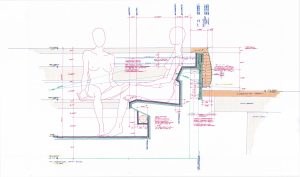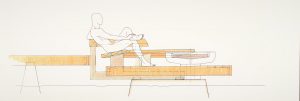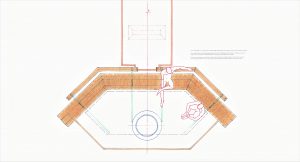Ergonomic Studies
My mother is part Native American and rather short at 4’5″. I have memories of family efforts to find comfortable seating for mom when out. So, when tasked with developing a custom therapy pool for a client’s wife, our first question became – is there a seat profile that comfortably supports both a 5’2″ female and a 6’0″ male, and second – how to deal with the gender buoyancy  differential. Comments from spa users seem to indicate a good result.
differential. Comments from spa users seem to indicate a good result.
Furniture development, particularly seating design, is demanding work. Balancing concerns of comfort, beauty and structural integrity for varied human seating positions and anatomies presents one with many layers…all compelling and rewarding to resolve.
Observations on the nature of seeing
Seeing our immediate environment is a layered process, beginning with data streaming from our two retinal fields to our brain and culminating with the constant construction of a mental map.
This construction will be varied and unique to each individual as we have innate differences in visual acuity and in attention to detail. The latter is particularly compounding as our visualizations are supplemented by information from three other senses, touch scent and sound.
differences in visual acuity and in attention to detail. The latter is particularly compounding as our visualizations are supplemented by information from three other senses, touch scent and sound.
Our maps are also shaped by cultural frames and personal experience…much of what is seen comes from what we expect to see.
These maps tend to be four dimensional in that they encompass the three dimensions of real space plus the dimension of time, involving thoughts of past present and future.
Our mental maps are dynamic, constantly updating merging new information with previous thoughts…creating an evolving composite of what is around us.
The notion of seeing as a composite raised a question regarding communication in design.
Traditional one, two and three point perspective methods present the subject as a snapshot, a view frozen in time with unfortunate tendencies for exaggeration. Peg’s garden deck is illustrated in ten point perspective presenting the subject as more of a composite with reduced levels of exaggeration. Might this rendering method, with its similarities to our mental map processes, be useful in design development and communication?
Viewing point is set a 29″ above deck surface and 28′ away, placing subject within a 46 degree cone. Final dimensions have been adjusted for RCC, perceived retinal curve compression.
Why not clothed?
Many have asked – “Why is there such detail…why not clothed?”  To design for the body one must understand the body, its dimensions mechanics bone and muscle. While the practice of figure drawing increases understanding, additional time to construct clothing seems unnecessary as the goal of design is not a drawing…nor a product, it is a memory…the retained experience of product.
To design for the body one must understand the body, its dimensions mechanics bone and muscle. While the practice of figure drawing increases understanding, additional time to construct clothing seems unnecessary as the goal of design is not a drawing…nor a product, it is a memory…the retained experience of product.
